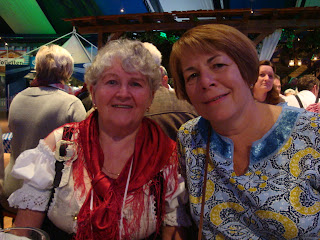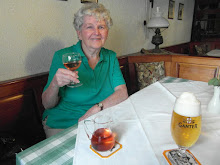Two views of Europa Park before entering: the one on the left from outside in a parking area; the other, inside the fence but not inside the amusement park itself.
Europa Park is a huge entertainment park in the manner of Disneyland and Disney World. It is the largest seasonal theme park in the world, with 4 million visitors a year. Each year it becomes larger, with new rides, new buildings and new live entertainment, attracting families and others from all over Europe and beyond.
The picture below: Blue and white are the colours of Bayern. The beer glasses (each is a Mass--1 Liter) are also Bavarian, with the label of the Hofbräuhaus on them.
In late September and early October the owner brings in a band and entertainers from the Hofbräuhaus in München. There is no cover charge and no cost other than for any food and drinks that one might order. This year, a Mass of beer (1 liter) cost Euro 8.80. Not cheap, but the entertainment was free. The largest Oktoberfest in the world is held in Munich each year during the last week in September and the first week in October, with the most famous beer hall being the Hofbräuhaus, which is open all year. The beer hall has nothing to do with the Oktoberfest, but they do have a huge tent during that period along with another 13 or so other large tents erected for the celebration.
Below, on the left: Bob, me, Jean and Leslie; on the right foreground, Erin. Hans took the picture.
Jean, Leslie and Hans in the picture at left; Hans and Erin in the one below right.
Our friends Jean Robertson and Leslie and Bob Climie with their daughter, Erin, all of whom had recently arrived in Germany on holiday (from Nova Scotia, British Columbia and Ontario) joined us at the Oktoberfest in Rust. The hall, which is large, had as many people as we have seen there (we've been several times), perhaps about 1,000, maybe more. We had gone early, so we were fortunate to find a front row table. Everyone sits next to another at picnic-style tables and benches stretching in long lines throughout the hall. At a fest, everyone, young or old, gets into the spirit of the day or evening. Before you know it, you are "prosting" with someone across from you or with someone beyond you.Jean and I
The server beside Bob is dressed in Black Forest-style Trachten.
The young girl opposite is also dressed in Trachten.
The fest brings to mind another visit to the Europa Park back in the early 1990s. In years past, Hans organized medieval dinner evenings there for Canadian friends and colleagues who were still here (before the closure of Canadian Forces Base Lahr in 1993 and 1994). These dinners were held during the winter months when the park was closed. (It still offers many forms of entertainment during those months, including the medieval dinners. The park closes for the season this year on 6 Nov 2011, re-opening in early April 2012.) On that particular occasion in 1993, we were one of the last to leave, getting home a little after midnight.
We had, of course, drunk quite a lot of red wine, as it flowed throughout the dinner--all as part of the price, which at that time was 95 Marks per person, steep for that era. Today, it costs 69 Euros per person, about $35 per person more than in 1993. We both felt at the time that it was well worth the cost as it included a six-course meal, all the wine you could drink, and entertainment that included a juggler and minstrels.
The group of us below at the dinner in June 1993, less than two months before Canadian Forces Headquarters Europe and Canadian Forces Hospital Europe--where each of us worked--closed.

Both of us in our bibs at the dinner. The spots on us were on the negatives received, so it is not that we were sloppy!
The morning after the night before, I said nothing. Instead, I went back out to the car, ready to go back to the park. First, though, I did a thorough search of the car. And there, on the floor between the seats, were my glasses! It had been too dark the night before and perhaps because of the wine or because I was tired, I had not found them then. It has ensured that I have never forgotten that Medieval Dinner at Europa Park. It also has ensured that I was very careful at the Oktoberfest this year!
 The six of us ate, drank beer and wine and soft drinks, clapped our hands to the live music, held arms and sang and swayed back and forth together--sitting and standing, but not on the benches as many of the younger crowd did, although it was tempting; in earlier days I suspect most of us would have done so.
The six of us ate, drank beer and wine and soft drinks, clapped our hands to the live music, held arms and sang and swayed back and forth together--sitting and standing, but not on the benches as many of the younger crowd did, although it was tempting; in earlier days I suspect most of us would have done so.
Below is the certificate Hans received as the organizer and go-between for Europa Park and Log Branch HQ
Back to the present with Bob, Jean and I in the swing of things, though I seem to be working at it! We are waving and clapping to the music, along with others
 The six of us ate, drank beer and wine and soft drinks, clapped our hands to the live music, held arms and sang and swayed back and forth together--sitting and standing, but not on the benches as many of the younger crowd did, although it was tempting; in earlier days I suspect most of us would have done so.
The six of us ate, drank beer and wine and soft drinks, clapped our hands to the live music, held arms and sang and swayed back and forth together--sitting and standing, but not on the benches as many of the younger crowd did, although it was tempting; in earlier days I suspect most of us would have done so.Below, a view of a part of the hall with a group standing on the benches
Note that both Hans and I were in Trachten. That means wearing traditional dress. Both the Schwarzwald and Bayern are known for theirs. That of the Black Forest is different than that in Bavaria, though all Trachten have similarities. Hans and I were in the Bavarian style dress; the servers were in Black Forest style.
A young woman serving a salad, pretzel, bread and soup.
Weisswurst is one such specialty and served with it is a Laugen Pretzel, along with sweet mustard that is made in Bayern. For me, the mustard is as important as those white sausages, perhaps even more important. (That mustard would also be excellent spread over a pork loin or shoulder before placing it in an oven to roast. Of course, not everyone likes it, as one of our friends did not care for it, perhaps because of its sweetness.)
Weisswurst and a Pretzel
A sharp knife always comes with the sausages as the skin is removed before eating them. There are several ways to remove the skin, but a good friend, who had grown up in Munich, showed us the way she had been taught as a child. Hans now demonstrates to other friends how to do it her way. Each time I have Weisswurst I have to remember all over again as I keep getting it wrong!
The key is putting the fork into the sausage correctly and then placing the knife correctly. For those who wish to do otherwise, some simply cut the skin down the length of the sausage and then remove the skin all at once. Others cut the sausage into sections and remove the skin from each section. Our late friend Linda's way is more fun! The pictures below show how to do it her Bavarian childhood way.
The fork is placed at the end as you see below left and right. The knife is placed above it on a similar slant as the fork (almost touching it). The last picture, below centre, shows the fork holding the piece of sausage and the tip of the knife holding onto the skin and slowly removing it, while lifting with the fork the piece that is being cut--minus the skin. Much easier, of course, watching someone do it in front of you. Hans demonstrates every time for me, although I think I got it right at the fest the first time!
 Note the mustard on the Bavarian plate. These pictures were actually taken at home when we had them a while ago.
Note the mustard on the Bavarian plate. These pictures were actually taken at home when we had them a while ago.The ingredients shown on the jar of mustard are as follows: water, brown sugar, mustard seeds, brandy and spices. Of course, the spices make a difference and they are not mentioned.
Below right, the mustard from the jar in our Bavarian dish.
The young crowd standing and clapping on the benches beside us and Hans on the right with a filled Hofbräuhaus beer glass.
The day of the Oktoberfest was a day to remember for all of us.



































Hi there, just became aware of your blog through Google,
ReplyDeleteand found that it's truly informative. I am gonna watch out for brussels. I'll be grateful if you continue this in future.
Lots of people will be benefited from your writing. Cheers!
My web blog dry skin red patches